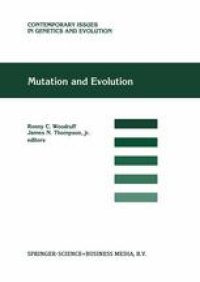
Ebook: Mutation and Evolution
Author: Brian Charlesworth Deborah Charlesworth (auth.) Ronny C. Woodruff James N. Thompson Jr. (eds.)
- Tags: Human Genetics, Evolutionary Biology, Animal Anatomy / Morphology / Histology
- Series: Contemporary Issues in Genetics and Evolution 7
- Year: 1998
- Publisher: Springer Netherlands
- Edition: 1
- Language: English
- pdf
Although debated since the time of Darwin, the evolutionary role of mutation is still controversial. In over 40 chapters from leading authorities in mutation and evolutionary biology, this book takes a new look at both the theoretical and experimental measurement and significance of new mutation. Deleterious, nearly neutral, beneficial, and polygenic mutations are considered in their effects on fitness, life history traits, and the composition of the gene pool. Mutation is a phenomenon that draws attention from many different disciplines. Thus, the extensive reviews of the literature will be valuable both to established researchers and to those just beginning to study this field. Through up-to-date reviews, the authors provide an insightful overview of each topic and then share their newest ideas and explore controversial aspects of mutation and the evolutionary process. From topics like gonadal mosaicism and mutation clusters to adaptive mutagenesis, mutation in cell organelles, and the level and distribution of DNA molecular changes, the foundation is set for continuing the debate about the role of mutation, fitness, and adaptability. It is a debate that will have profound consequences for our understanding of evolution.
Although debated since the time of Darwin, the evolutionary role of mutation is still controversial. In over 40 chapters from leading authorities in mutation and evolutionary biology, this book takes a new look at both the theoretical and experimental measurement and significance of new mutation. Deleterious, nearly neutral, beneficial, and polygenic mutations are considered in their effects on fitness, life history traits, and the composition of the gene pool. Mutation is a phenomenon that draws attention from many different disciplines. Thus, the extensive reviews of the literature will be valuable both to established researchers and to those just beginning to study this field. Through up-to-date reviews, the authors provide an insightful overview of each topic and then share their newest ideas and explore controversial aspects of mutation and the evolutionary process. From topics like gonadal mosaicism and mutation clusters to adaptive mutagenesis, mutation in cell organelles, and the level and distribution of DNA molecular changes, the foundation is set for continuing the debate about the role of mutation, fitness, and adaptability. It is a debate that will have profound consequences for our understanding of evolution.
Although debated since the time of Darwin, the evolutionary role of mutation is still controversial. In over 40 chapters from leading authorities in mutation and evolutionary biology, this book takes a new look at both the theoretical and experimental measurement and significance of new mutation. Deleterious, nearly neutral, beneficial, and polygenic mutations are considered in their effects on fitness, life history traits, and the composition of the gene pool. Mutation is a phenomenon that draws attention from many different disciplines. Thus, the extensive reviews of the literature will be valuable both to established researchers and to those just beginning to study this field. Through up-to-date reviews, the authors provide an insightful overview of each topic and then share their newest ideas and explore controversial aspects of mutation and the evolutionary process. From topics like gonadal mosaicism and mutation clusters to adaptive mutagenesis, mutation in cell organelles, and the level and distribution of DNA molecular changes, the foundation is set for continuing the debate about the role of mutation, fitness, and adaptability. It is a debate that will have profound consequences for our understanding of evolution.
Content:
Front Matter....Pages i-2
Some evolutionary consequences of deleterious mutations....Pages 3-19
Risk of population extinction from fixation of deleterious and reverse mutations....Pages 21-27
Deleterious mutation accumulation in organelle genomes....Pages 29-39
Mutation-selection balance with multiple alleles....Pages 41-47
Deleterious mutations in animal mitochondrial DNA....Pages 49-60
Requisite mutational load, pathway epistasis, and deterministic mutation accumulation in sexual versus asexual populations....Pages 61-69
Evolution by nearly-neutral mutations....Pages 71-81
Compensatory neutral mutations and the evolution of RNA....Pages 83-90
The amount and pattern of DNA polymorphism under the neutral mutation hypothesis....Pages 91-101
Adaptive mutagenesis: a process that generates almost exclusively beneficial mutations....Pages 103-107
The fate of competing beneficial mutations in an asexual population....Pages 109-125
An embarrassment of riches: the stochastic generation of beneficial mutations....Pages 127-144
Selection, convergence, and intragenic recombination in HLA diversity....Pages 145-155
Mutation and conflicts between artificial and natural selection for quantitative traits....Pages 157-169
Measuring spontaneous deleterious mutation process....Pages 171-181
Polygenic mutation in Drosophila melanogaster: genotype ? environment interaction for spontaneous mutations affecting bristle number....Pages 183-197
Inferences on genome-wide deleterious mutation rates in inbred populations of Drosophila and mice....Pages 199-215
How should we explain variation in the genetic variance of traits?....Pages 217-228
Evolution of intermediate selfing rates in plants: pollination ecology versus deleterious mutations....Pages 229-239
Mathematical properties of mutation-selection models....Pages 241-253
Mutation and senescence: where genetics and demography meet....Pages 255-265
Mutation rates in mangroves and other plants....Pages 267-278
Asymmetrical DNA replication promotes evolution: disparity theory of evolution....Pages 279-298
Directional mutational pressure affects the amino acid composition and hydrophobicity of proteins in bacteria....Pages 299-314
Mutation and selection at silent and replacement sites in the evolution of animal mitochondrial DNA....Pages 315-324
Enigma of Y chromosome degeneration: Neo-Y and Neo-X chromosomes of Drosophila miranda a model for sex chromosome evolution....Pages 325-331
Major impacts of gonadal mosaicism on hereditary risk estimation, origin of hereditary diseases, and evolution....Pages 333-347
Discovery of numerous clusters of spontaneous mutations in the specific-locus test in mice necessitates major increases in estimates of doubling doses....Pages 349-358
Clusters of new identical mutants and the fate of underdominant mutations....Pages 359-367
Mutation and selection within the individual....Pages 369-382
Towards a theory of evolutionary adaptation....Pages 383-391
A pleiotropic model of phenotypic evolution....Pages 393-407
Population differentiation through mutation and drift — a comparison of genetic identity measures....Pages 409-420
Inferring the major genomic mode of dominance and overdominance....Pages 421-443
Genetic measurement theory of epistatic effects....Pages 445-462
....Pages 463-487